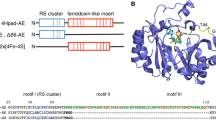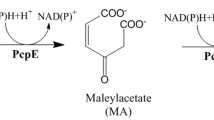Abstract
The enzymatic conversion of formaldehyde to CH3S-CoM in crude extracts of Methanobacterium thermoautotrophicum was used as a means to investigate the methyl-tetrahydromethanopterin: HS-CoM methyltransferase reaction. All components necessary for formaldehyde conversion were shown to be present in a soluble protein fraction. This soluble cell fraction still contained a major amount of corrinoids. Apart from tetrahydromethanopterin no other soluble cofactors were required for formaldehyde conversion. The dependence of the system on catalytic amounts of ATP was shown to be specific. Several nucleoside triphosphates or ADP were unable to substitute for ATP. Remarkably, various strong reducing systems, especially titanium(III)citrate could replace ATP to a large extent. The ATP-dependent formaldehyde conversion to CH3S-CoM was inhibited in the presence of nitrous oxide, detergents or 2′,3′-dialdehyde-ATP. The results support a role for a corrinoid protein in the methyl-tetrahydromethanopterin: HS-CoM methyltransferase reaction at which ATP is involved in the activation of this protein, probably in the conversion of inactive B12a or B12r to active B12s.
Similar content being viewed by others
Abbreviations
- HS-CoM:
-
Coenzyme M, 2-mercaptoethanesulfonate
- CH3S-CoM:
-
methylcoenzyme M, 2-(methylthio)ethanesulfonate
- H4MPT:
-
5,6,7,8-tetrahydromethanopterin
- BES:
-
2-bromoethanesulfonate
- BCE:
-
boiled cell-free extract
- DTT:
-
dithiothreitol
- TCS:
-
3,3′,4,5′-tetrachlorosalicylanilide
- DNTB:
-
2,2′-dinitro-5,5′-dithiobenzoic acid
- TES:
-
N-tris(hydroxymethyl)methyl-2-aminoethanesulfonate
- HEPES:
-
N-2-hydroxyethylpiperazine-N′-2-ethanesulfonic acid
- PIPES:
-
piperazine-N,N′-bis[2-ethanesulfonic acid]
- AMP-PNP:
-
5′-adenylyl imidophosphate
References
Ankel-Fuchs D, Thauer RK (1986) Methane formation from methylcoenzyme M in a system containing methylcoenzyme M reductase, component B, and reduced cobalamin. Eur J Biochem 156:171–177
Balderstone WL, Payne WJ (1976) Inhibition of methanogenesis in salt march sediments and whole-cell suspensions of methanogenic bacteria by nitrogen oxides. Appl Environ Microbiol 32:264–269
Banks RGS, Henderson RJ, Pratt JM (1967) Reactions of nitrous oxide with some transition-metal complexes. J Chem Soc, Chem Comm:387–388
Bott M, Eikmanns B, Thauer RK (1986) Coupling of carbon monoxide oxidation to CO2 and H2 with the phosphorylation of ADP in acetate-grown Methanosarcina barkeri. Eur J Biochem 159:393–398
Brot N, Weissbach H (1965) Enzymatic synthesis of methionine. Chemical alkylation of the enzyme-bound cobamide. J Biol Chem 240:3064–3070
Daniels L, Fuchs G, Thauer RK, Zeikus JG (1977) Carbon monoxide oxidation by methanogenic bacteria. J Bacteriol 132:118–126
Easterbrook-Smith SB, Wallace JC, Keech DB (1976) Pyruvate carboxylase: Affinity labelling of the magnesium adenosine triphosphate binding site. Eur J Biochem 62:125–130
Ellman GL (1958) A colorimetric method for determining low concentrations of mercaptans. Arch Biochem Biophys 74:443–450
Escalante-Semerena JC, Leigh JA, Wolfe (1984) New insights into the biochemistry of methanogenesis from H2 and CO2. In: Crawfold RL, Hanson RS (eds) Microbial growth on C1-compounds. Proceedings of the 4th International Symposium American Society for Microbiology, Washington, pp 191–198
Friedrich W (1975) Vitamine B12 und verwandte Corrinoide. In: Ammon R, Dirscherl W (eds) Fermente, Hormone, Vitamine, vol 3/2. Thieme, Stuttgart, pp 99, 122–123
Gunsalus RP, Wolfe RS (1978) ATP activation and properties of the methylcoenzyme M reductase system in Methanobacterium thermoautotrophicum. J Bacteriol 135:851–857
Hutten TJ, De Jong MH, Peeters BPH, Van der Drift C, Vogels GD (1981) Coenzyme (2-mercaptoethanesulfonic acid)-derivatives and their effects on methane formation from carbon dioxide and methanol by cell-free extracts of Methanosarcina barkeri. J Bacteriol 145:27–34
Keltjens JT, Vogels GD (1988) Methanopterin and metanogenic bacteria. BioFactors 1:95–103
Keltjens JT, Caerteling GC, Vogels GD (1986) Methanopterin and tetrahydromethanopterin derivatives: Isolation, synthesis, and identification by High Performance Liquid Chromatography, Meth Enzymol, vol 22 pp 412–425
McBride BC, Wolfe RS (1971) A new coenzyme of methyl transfer, coenzyme M. Biochemistry 10:2317–2324
Nash T (1953) The colometric estimation of formaldehyde by means of the Hantzch reaction. Biochem J 55:416–421
Naumann E, Fahlbusch K, Gottschalk G (1984) Presence of a trimethylamine: HS-coenzyme M methyltransferase in Methanosarcina barkeri. Arch Microbiol 138:79–83
Poirot C, Kengen SWM, Valk E, Keltjens JT, Van der Drift C, Vogels GD (1987) Formation of methylcoenzyme M from formaldehyde by cell-free extracts of Methanobacterium thermoautotrophicum. Evidence for the involvement of a corrinoid-containing methyltransferase. FEMS Microbiol Lett 40:7–13
Rouviere PE, Wolfe RS (1987) 2′,3′-Dialdehyde of ATP: a specific irreversible inhibitor of component A3 of the methylreductasesystem of Methanobacterium thermoautotrophicum. J Bacteriol 169:1737–1739
Sauer FD (1986) Tetrahydromethanopterin methyltransferase, a component of the methane synthesizing complex of Methanobacterium thermoautotrophicum. Biochem Biophys Res Commun 136:542–547
Schrauzer GN, Stadtbauer EA (1975) Ethanolamine ammonialyase: Inactivation of the holoenzyme by N2O and the mechanism of action of coenzyme B12. Bioinorg Chem 4:185–198
Schrauzer GN, Holland RJ, Seck JA (1971) The mechanism of coenzyme B12 action in dioldehydrase. J Amer Chem Soc 93:1503–1505
Schulz H, Fuchs G (1986) Cobamide-containing membrane protein complex in Methanobacterium. FEBS Lett 198:279–282
Sedmak JJ, Grossberg SE (1977) A rapid, sensitive, and versatile assay for protein using Coomassie Brilliant Blue G250. Anal Biochem 79:544–552
Shapiro S (1982) Do corrinoids function in the methanogenic dissimilation of methanol by Methanosarcina barkeri? Can J Microbiol 28:629–635
Shapiro S, Wolfe RS (1980) Methyl-coenzyme M, an intermediate in methanogenic dissimilation of C1-compounds by Methanosarcina barkeri. J Bacteriol 141:728–734
Stupperich E, Fuchs G (1984) Autotrophic synthesis of activated acetic acid from two CO2 in Methanobacterium thermoautotrophicum. II. Evidence for different origins of acetate carbon atoms. Arch Microbiol 139:14–20
Taylor CD, Wolfe RS (1974) A simplified assay for coenzyme M (HSCH2CH2SO3). Resolution of methylcobalamin-coenzyme M methyltransferase and use of sodium borohydride. J Biol Chem 249:4886–4890
Taylor RT (1982) B12-dependent methionine biosynthesis. In: Dolphin D (ed) B12, vol 2. John Wiley, New York, pp 307–355
Van Beelen P, Thiemessen HL, De Cock RM, Vogels GD (1983) Methanogenesis and methanopterin conversion by cell-free extracts of Methanobacterium thermoautotrophicum. FEMS Microbiol Lett 18:135–138
Van der Meyden P, Jansen LPJM, Van der Drift C, Vogels (1983) Involvement of corrinoids in the methylation of coenzyme M (2-mercaptoethanesulfonic acid) by methanol and enzymes from Methanosarcina barkeri. FEMS Microbiol Lett 19:247–251
Van der Meyden P, Van der Drift C, Vogels GD (1984) Methanol conversion in Eubacterium limosum. Arch Microbiol 138:360–364
Vogels GD, Van Beelen P, Keltjens JT, Van der Drift C (1984) Structure and function of methanopterin and other 7-methylpterins of methanogenic bacteria. In: Crawford RL, Hanson RS (eds) Microbial growth on C1-compounds. Proceedings of the 4th International Symposium American Society for Microbiology, Washington, pp 183–187
Whitman WB, Wolfe RS (1983) Activation of the methylreductase system from Methanobacterium bryantii by ATP. J Bacteriol 154:640–649
Wood JM (1982) Mechanisms for B12-dependent methyl transfer. In: Dolphin D (ed) B12, vol 2. John Wiley, New York, pp 151–164
Wood JM, Wolfe RS (1966) Alkylation of an enzyme in the methane forming system of Methanobacillus omelianskii. Biochem Biophys Res Common 22:119–123
Zehnder AJB, Wuhrmann K (1976) Titanium(III)citrate as a nontoxic oxidation-reduction buffering system for the culture of obligate anaerobes. Science 194:1165–1166
Author information
Authors and Affiliations
Rights and permissions
About this article
Cite this article
Kengen, S.W.M., Mosterd, J.J., Nelissen, R.L.H. et al. Reductive activation of the methyl-tetrahydromethanopterin: coenzyme M methyltransferase from Methanobacterium thermoautotrophicum strain ΔH. Arch. Microbiol. 150, 405–412 (1988). https://doi.org/10.1007/BF00408315
Received:
Accepted:
Issue Date:
DOI: https://doi.org/10.1007/BF00408315




